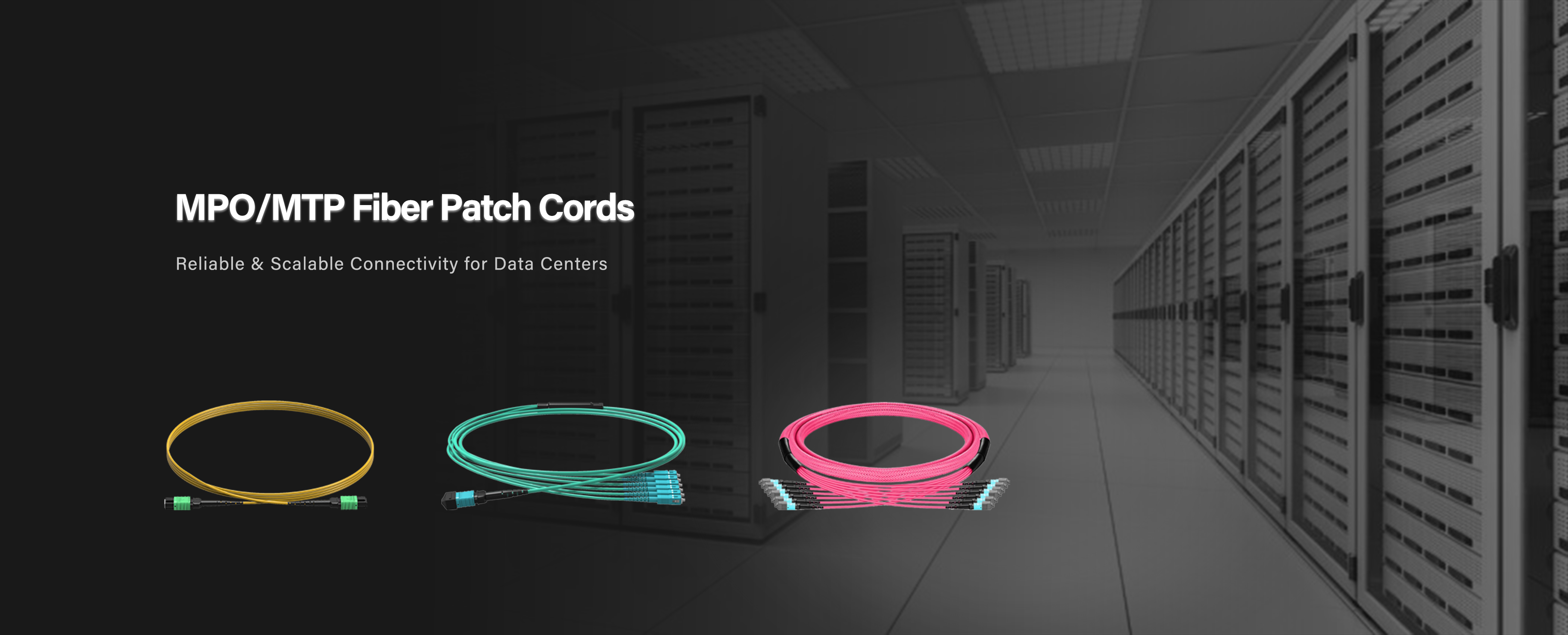Understanding OFNP, OFNR, LSZH, and PVC Ratings in Fiber Optic Patch Cables
2025-10-23
When selecting fiber optic patch cables for data centers, commercial buildings, or telecom facilities, you may often notice markings such as OFNP, OFNR, LSZH, and PVC on the cable jacket. These terms indicate important information about fire resistance, smoke emission, and installation environments. Understanding their differences ensures both safety compliance and optimal performance in your fiber network infrastructure.
1. What Do OFNP and OFNR Mean?
Both OFNP and OFNR are fire-rating designations defined by the National Fire Protection Association (NFPA) and are widely used in North America to classify fiber optic cables based on their flame-retardant properties.
OFNP – Optical Fiber Nonconductive Plenum
Definition: The highest fire-resistance rating for indoor fiber optic cables.
Installation environment: Suitable for plenum spaces, such as air-handling ducts, raised floors, or ceilings used for ventilation.
Performance:
Excellent flame-retardant properties.
Very low smoke and toxic gas emission.
Often required in high-density buildings or data centers for enhanced fire safety.
Keyword focus: OFNP plenum cable, fire-resistant fiber optic cable, data center cabling standard.
OFNR – Optical Fiber Nonconductive Riser
Definition: A slightly lower rating than OFNP, designed for vertical riser shafts or between floors.
Installation environment: Used in riser applications, such as connecting equipment across building floors.
Performance:
Good flame resistance but not suitable for plenum air spaces.
Cost-effective option for most in-building fiber installations.
Keyword focus: OFNR riser cable, vertical fiber optic cable, building communication wiring.
2. LSZH and PVC: Jacket Materials and Safety Standards
Apart from OFNP/OFNR ratings, the outer jacket material also affects the safety and environmental performance of fiber cables. The two most common types are LSZH (Low Smoke Zero Halogen) and PVC (Polyvinyl Chloride).
LSZH – Low Smoke Zero Halogen
Definition: Jacket material that emits minimal smoke and no toxic halogen gases when exposed to fire.
Advantages:
Safer for personnel and sensitive equipment.
Environmentally friendly and compliant with EU RoHS standards.
Ideal for confined public areas, transportation systems, or data centers.
Keyword focus: LSZH fiber patch cable, low smoke fiber cable, halogen-free optical cable.
PVC – Polyvinyl Chloride
Definition: A durable, cost-efficient jacket material commonly used in general-purpose applications.
Advantages:
Flexible and easy to install.
Provides good mechanical strength and insulation.
Best suited for non-critical environments where fire safety is not a major concern.
Keyword focus: PVC fiber optic cable, durable fiber jacket, cost-effective patch cord.
3. OFNP vs. OFNR vs. LSZH vs. PVC — Comparison Table
Property
OFNP
OFNR
LSZH
PVC
Meaning
Plenum-rated
Riser-rated
Low Smoke Zero Halogen
Polyvinyl Chloride
Fire Resistance
★★★★★ (Highest)
★★★★☆
★★★★☆
★★☆☆☆
Smoke Emission
Very Low
Moderate
Very Low
High
Toxic Gas Emission
Very Low
Moderate
None
High
Cost
$$$$
$$$
$$
$
Typical Applications
Data centers, ventilation ducts
Vertical risers, building shafts
Public areas, enclosed spaces
General indoor/outdoor use
4. Choosing the Right Fiber Patch Cable for Your Environment
Selecting the appropriate fiber optic cable depends on your installation site, safety requirements, and regulatory standards:
Choose OFNP cables for data centers, hospitals, and office buildings where air-handling spaces are present.
Use OFNR cables for riser installations connecting equipment between floors.
Opt for LSZH cables in European projects or transportation systems requiring low smoke and zero halogen.
Select PVC cables for general-purpose networks that prioritize flexibility and cost-effectiveness.
Conclusion
Understanding these designations—OFNP, OFNR, LSZH, and PVC—is crucial for engineers, system integrators, and network managers who prioritize both performance and safety in fiber optic installations.At RUIARA, we provide a wide range of fiber optic patch cords meeting international fire safety and environmental standards, available in single-mode (OS2) and multimode (OM3/OM4/OM5) configurations with LSZH, PVC, OFNR, and OFNP options.
For technical specifications, OEM customization, or distributor inquiries, contact us or visit www.ruiara.com to learn more.
View More
Global Sources Consumer Electronics (Autumn 2025) — Show Wrap-Up
2025-10-14
Dates: October 11–14, 2025Venue: AsiaWorld-Expo, Hong Kong
Ruiara Showcases Fiber Connectivity & Audio Solutions
The Global Sources Consumer Electronics Show (Autumn 2025) is drawing to a successful close. Over four vibrant days in Hong Kong, Ruiara welcomed visitors from Europe, the Middle East, Southeast Asia, and the Americas. Our booth featured three core product lines: audio adapter cables, MPO trunk assemblies, and fiber-optic patch cords tailored for data centers and industrial networking.
Highlights from the Booth
High international traffic: We received a large number of foreign buyers and technical specialists, many of whom scheduled follow-up meetings on site.
Strong product interest: Visitors were particularly engaged by our MPO/MTP high-density solutions and low-loss patch cord builds for high-bandwidth links, as well as plug-and-play audio adapters for consumer and professional gear.
On-site sampling: Multiple customers took sample cables on the spot (MPO trunk & LC-LC patch cords, as well as TOSLINK/3.5 mm/2RCA adapters) for evaluation in their labs and pilot projects.
Quality & lead-time feedback: Buyers praised the stable performance, consistent polishing quality, and responsive lead times.
Application coverage: Use cases discussed ranged from data centers and edge facilities to industrial automation and digital audio.
Products on Display
MPO/MTP Trunk & Harness Cables: 12–144 fibers, OM3/OM4/OM5 & OS2 options; polarity A/B/C; customized length and pulling eye.
Fiber-Optic Patch Cords: LC/SC/FC/SMA; LSZH/OFNR jackets; tight buffer or loose-tube builds for varied environments.
Audio Adapter Cables: USB/Type-C to TOSLINK, TOSLINK to 2RCA/3.5 mm, and bi-directional models for SPDIF PCM applications.
What’s Next
We are now coordinating sample testing schedules and engineering specifications with interested buyers. If you visited our booth and would like additional documentation (datasheets, compliance reports, or pricing), our team is ready to help.
Contact us: sales@ruiara.comCall to action: Tell us your fiber count, length, jacket type, and connector options, and we’ll prepare a tailored quotation and sample plan within 24–48 hours.
View More
The Evolution of Fiber-Optic Communication and the Rise of Hollow-Core Fiber Technology
2025-10-21
The journey of optical communication has been defined by humanity’s constant quest to transmit information faster and farther. From ancient beacon towers and optical semaphore lines in the Napoleonic era to the invention of the telegraph in the 19th century, each milestone shortened the perceived distance between people. The first transatlantic cable laid in 1858, capable of sending Morse code across the ocean, symbolized the dawn of global interconnection.
The following decades witnessed radio waves transforming communication, yet their bandwidth limitations and interference issues revealed the need for better media. Coaxial cables, utilizing refined conductive and insulating materials, dominated long-distance transmission until the late 20th century. The discovery by Charles Kao and George Hockham in the 1960s—that purified glass could guide light over kilometers—marked the beginning of the fiber-optic era. When Corning introduced low-loss glass fiber in the 1970s, the foundation for modern internet infrastructure was established.
The Science Behind Hollow-Core Fiber (DNANF)
Unlike traditional optical fibers that rely on a solid glass core, hollow-core fibers (HCFs) guide light through a central air channel surrounded by structured glass layers. Among them, the Double Nested Anti-Resonant Nodeless Fiber (DNANF) stands out as a revolutionary design.
This architecture works through anti-resonant reflection and inhibited coupling, ensuring that light remains confined in the air core rather than interacting with the glass. This innovation eliminates key loss mechanisms—especially Rayleigh scattering—that fundamentally limit conventional silica fibers.
Manufacturing DNANF requires precise control over leakage loss, surface scattering, and micro-bending effects, all of which depend on the fiber geometry and wavelength. Sophisticated modeling tools are used to optimize these parameters, enabling stable, low-loss performance across wide spectral windows.
Unprecedented Performance Metrics
Recent experiments have demonstrated extraordinary results: the newly developed HCF2 fiber achieved a record attenuation of 0.091 dB/km at 1550 nm—the lowest optical loss ever recorded. This surpasses the long-standing performance barrier of conventional silica fibers.
Beyond the record-low attenuation, DNANF exhibits an exceptional transmission window. It maintains losses below 0.1 dB/km across 144 nm (18 THz) and below 0.2 dB/km over 66 THz, a 260% improvement compared to standard telecom fibers.
Advanced testing, including optical time-domain reflectometry and repeated cutback measurements, confirmed uniform loss across the fiber’s 15 km length. The fiber also shows outstanding mode purity (intermodal interference < −70 dB/km), ensuring superior signal quality for ultra-long-haul communication.
Distinct Technical Advantages
In addition to its record performance, hollow-core fiber technology provides multiple benefits for next-generation optical systems. Its chromatic dispersion at 1550 nm is only 3.2 ps/nm/km, nearly seven times lower than in conventional fibers, reducing the need for complex dispersion compensation.
Transmission speed is another highlight—since light travels primarily through air, the propagation velocity increases by up to 45% compared with solid-core fibers. The air-guided structure also suppresses nonlinear optical effects, allowing high-power and high-data-rate transmission without signal distortion.
Production involves a highly controlled stack-and-draw process using thin glass capillaries. The key layer, around 500 nm thick, must be precisely maintained to achieve consistent anti-resonant behavior. Advanced microscopy and multi-wavelength testing ensure geometric and optical quality control.
Broader Impact and Future Potential
The implications of DNANF extend beyond conventional communication systems. Simulations indicate that it can function effectively across a wavelength range from 700 nm to over 2400 nm, enabling compatibility with various amplification systems.
For example, ytterbium-based amplifiers (≈1060 nm) offer 13.7 THz bandwidth, bismuth-doped amplifiers deliver 21 THz across O/E/S bands, and thulium/holmium systems (≈2000 nm) provide over 31 THz. Customizing DNANF for these bands could multiply current transmission bandwidths by five to ten times.
Future designs may reduce losses even further—to around 0.01 dB/km—through larger cores and improved mechanical reinforcement. Although such fibers might sacrifice flexibility, their performance advantages make them suitable for high-power laser transport and ultra-long-distance communication.
Outlook: Toward the Next Generation of Optical Networks
DNANF represents a defining step forward in optical waveguide engineering. Combining ultra-low loss, wide spectral bandwidth, and enhanced signal stability, it paves the way for faster, more energy-efficient, and longer-reaching fiber networks.
Applications will span telecom infrastructure, data centers, industrial laser delivery, sensing systems, and scientific instrumentation—any field requiring precision and low-loss optical transmission. As fabrication methods mature and scalability improves, hollow-core fiber is poised to become a cornerstone of next-generation communication technology.
This breakthrough demonstrates that with innovative waveguide design, the long-standing physical barriers of glass fiber transmission can indeed be surpassed—ushering in a new era for optical connectivity.
View More
LC Duplex and LC Uniboot: Evolving Toward Smarter Fiber Cabling
2025-10-13
The Evolution of LC Patch Cables
The LC connector has long been the standard for reliable, compact fiber optic connectivity. But as data centers grow denser and more power-hungry, cable management and airflow have become just as important as transmission quality itself.
That’s where the two major LC designs — LC Duplex and LC Uniboot — take different paths. They share the same interface, yet serve very different environments. Understanding these differences can help you optimize both performance and space utilization in your fiber network.
LC Duplex: The Classic and Universal Choice
LC Duplex cables are built with two separate connectors joined by a clip — one for transmitting (Tx) and one for receiving (Rx).Each fiber has its own jacket, usually 2.0 mm or 3.0 mm, giving installers flexibility and durability.
Their advantages are clear:
Simple structure, easy replacement
Compatible with most existing panels and devices
Cost-effective for telecom, LAN, and industrial networks
However, when hundreds or thousands of cables fill a rack, their individual jackets occupy more space, restricting airflow and increasing maintenance difficulty.
LC Uniboot: Designed for High-Density Data Centers
In contrast, LC Uniboot cables combine both fibers within a single compact housing and jacket.This small structural change makes a huge impact: it reduces cable bulk, improves rack organization, and allows better airflow between devices.
Modern Uniboot connectors also feature tool-free polarity reversal, letting engineers switch Tx/Rx orientation instantly — an essential function during deployment and troubleshooting.
Key advantages:
50% reduction in cable volume
Improved airflow and thermal balance in racks
Easier polarity management
Ideal for high-density switches, cloud systems, and MPO-LC breakout cables
Airflow: The Hidden Factor in Network Stability
Airflow is often overlooked, yet it determines how efficiently heat can be removed from rack-mounted equipment.Traditional duplex bundles tend to form “airflow barriers,” while Uniboot’s slim, parallel layout allows cold air to move freely through cable rows — keeping switches cooler and extending hardware lifespan.
Better airflow doesn’t just save space; it saves energy and increases system uptime — a direct gain for large-scale data centers.
Which One Fits Your Needs?
Environment
Recommended Connector
Key Reason
Standard telecom rooms
LC Duplex
Cost-effective and easy to maintain
Office networks or OEM equipment
LC Duplex
Simple, robust structure
High-density racks & 400G/800G systems
LC Uniboot
Space-saving and airflow-friendly
Cloud computing or modular systems
LC Uniboot
Flexible polarity, tidy routing
Conclusion
Both LC Duplex and LC Uniboot are reliable and high-performance fiber solutions — the difference lies in how your system grows.For legacy setups, LC Duplex remains practical.For expanding data centers that demand order, efficiency, and optimized airflow, LC Uniboot is the future-ready choice.
View More
How Hybrid FC-MPO Trunk Cables Enable Smooth Transition to High Speed Networking
2025-09-15
The Shift to 40G and 100G Speeds
Data centers and high performance networks are moving rapidly toward 40G, 100G, and beyond. Older infrastructures built around LC or FC connectors find it expensive to rewire everything. Hybrid trunk cables help bridge connectors on existing test equipment or older devices to MPO backbone used for modern high speed devices.
Hybrid Trunk Cables as Transition Tools
A hybrid trunk cable with FC on one end and MPO on the other allows test benches, patch panels, or older switches with FC ports to connect directly to newer MPO-based switch architecture. That avoids needing many adapters or making custom cable assemblies, saving cost and reducing insertion loss.
Matching Core Counts for Speed Standards
High speed transceivers like SR4 or SR8 require specific fiber count. For example 40G SR4 uses four lanes, each with transmit and receive fibers. Hybrid cables with 8 core MPO or 12 core MPO on the backbone side permit breakout configurations. Using proper fiber counts ensures all lanes operate as intended.
Testing Equipment and Calibration
Test labs often use FC connectors in instruments like optical power meters, OTDRs, etc. Hybrid trunk cables allow direct calibration and measurement without converting between connectors. That helps in ensuring the test setup reflects the real performance of the network backbone.
Reducing Downtime During Upgrades
Replacing large sections of backbone fiber is costly in both time and risk. Hybrid trunk cables allow gradual migration. Until all equipment supports MPO or newer connector types, hybrid setups enable old and new systems to coexist and interoperate without entire infrastructure rebuild.
Future-Proofing Network Investments
Investing in hybrid cables now prevents repeated expensive upgrades later. As more network equipment shifts to parallel optics and MPO backbone, having hybrid trunk cables avoids stranded equipment and maintains compatibility across generations.
View More






